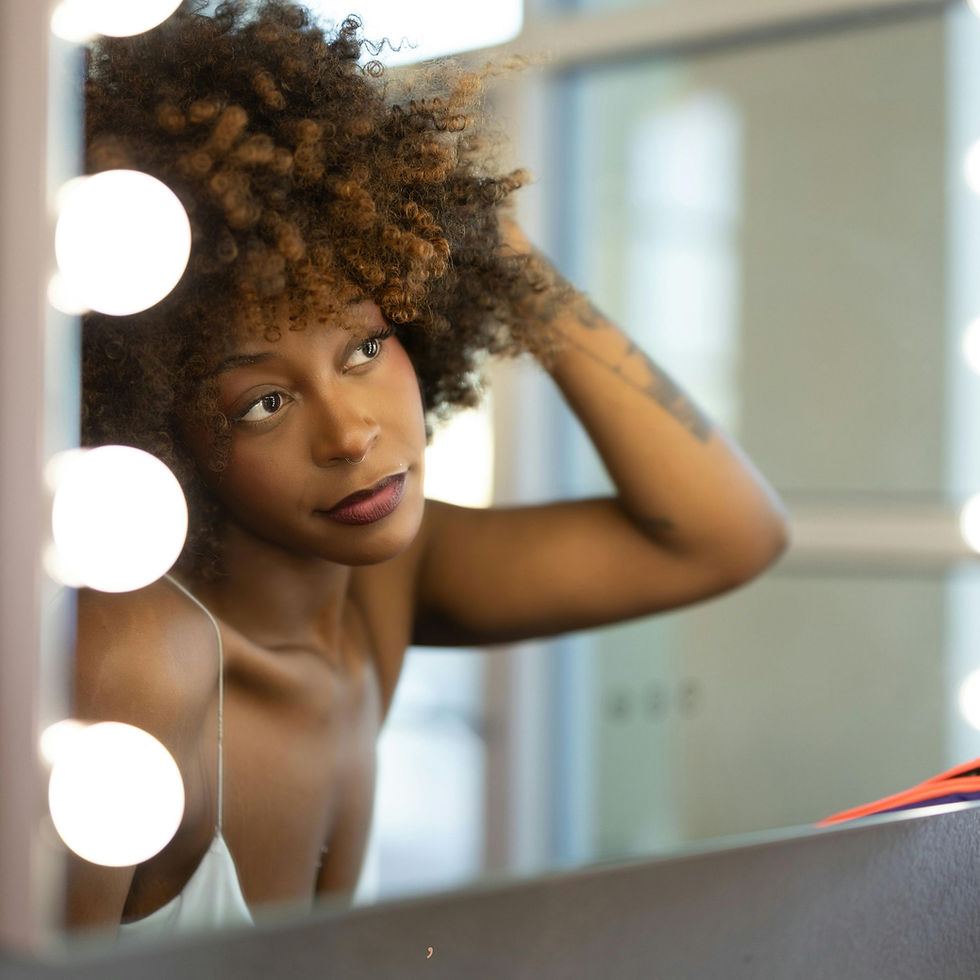
Maintaining Healthy Hair While Wearing Protective Styles
- Stacy Ngina
- Aug 5, 2024
- 4 min read
Protective styles are a cornerstone in many hair care routines, especially for those with natural hair. These styles, ranging from braids to twists, wigs, and weaves, offer numerous benefits including reduced manipulation, protection from environmental damage, and a stylish way to manage hair growth. However, maintaining healthy hair while wearing protective styles requires a diligent and thoughtful approach. Here’s how you can ensure your hair remains healthy and vibrant beneath your protective style.
Understanding Protective Styles
Protective styles are hairstyles that tuck the ends of the hair away and minimize manipulation. Popular options include:
Braids (box braids, cornrows, Ghana braids)
Twists (two-strand twists, Marley twists, Havana twists)
Wigs (lace fronts, full lace, synthetic or human hair)
Weaves (sew-ins, glue-ins)
Updos (buns, chignons)
Each of these styles can significantly reduce the daily stress placed on your hair, but it's crucial to prepare your hair properly and care for it correctly while it’s in the protective style.
Preparation is Key
Before installing any protective style, it's essential to prepare your hair. Proper preparation can prevent damage and ensure that your hair remains healthy.
Cleanse Thoroughly: Start with a clean slate. Use a sulfate-free shampoo to remove any buildup from products, oils, and dirt. A clean scalp is less prone to irritation and infection.
Deep Condition: Moisture is crucial for healthy hair. Deep condition your hair to infuse it with the necessary moisture and nutrients. Look for deep conditioners rich in natural oils, proteins, and vitamins.
Trim Ends: Trim any split ends to prevent them from worsening. This will help maintain the integrity of your hair while it’s in the protective style.
Moisturize and Seal: Apply a leave-in conditioner or a moisturizing cream to your hair, followed by a natural oil to seal in the moisture. This step helps to keep your hair hydrated for an extended period.
Installation Considerations
The way your protective style is installed can significantly impact the health of your hair. Here are some key points to consider:
Choose a Skilled Stylist: If you’re not doing the style yourself, choose a stylist who has experience with protective styles. They should understand the importance of not pulling the hair too tightly and ensuring that your natural hair is not overly stressed.
Avoid Tight Styles: Styles that are too tight can cause traction alopecia, which is hair loss due to pulling on the hair follicles. Make sure your style is comfortably installed.
Use Quality Hair Extensions: If your style involves extensions, invest in good-quality hair. Poor-quality hair can cause irritation and damage your natural hair.
Limit the Use of Heavy Products: Avoid heavy gels and creams that can cause buildup on your scalp and hair.
Maintenance While in Protective Styles
Once your protective style is installed, maintaining your hair’s health requires ongoing care:
Moisturize Regularly: Even in a protective style, your hair needs moisture. Use a light, water-based leave-in conditioner or a moisturizing spray. Focus on the scalp and the length of your hair, especially the ends.
Scalp Care: Keep your scalp clean and healthy. Use a gentle cleanser or a diluted shampoo to clean your scalp if needed. An astringent like witch hazel can also be used to cleanse the scalp without removing too much moisture.
Oiling Your Scalp: Regularly oil your scalp with light oils such as jojoba, argan, or coconut oil to keep it moisturized. Avoid using too much oil to prevent clogging your pores.
Protect at Night: Use a satin or silk scarf, bonnet, or pillowcase to protect your hair while you sleep. This reduces friction and prevents your style from becoming frizzy.
Mind the Edges: Your edges are delicate and can be easily damaged. Apply a light oil or edge control product to keep them smooth and protected. Avoid styles that put excessive tension on your edges.
When to Take a Break
While protective styles are beneficial, it's important to give your hair a break between styles. Here’s why and how:
Avoid Prolonged Wear: Do not keep a protective style in for too long. Generally, styles should be kept for 6-8 weeks. Keeping them in for longer can lead to matting, tangling, and breakage.
Let Your Hair Breathe: Give your hair at least a week or two to breathe between styles. This allows your scalp to rest and your hair to regain strength.
Deep Treatments: During the break, deep condition and treat your hair with protein treatments to rebuild strength and elasticity.
Post-Style Hair Care
After removing a protective style, your hair will need extra care to recover:
Detangle Gently: Carefully detangle your hair with a wide-tooth comb or your fingers. Use a detangling spray or conditioner to make this process easier and prevent breakage.
Cleanse Thoroughly: Shampoo your hair to remove any buildup from products and dirt that may have accumulated while your hair was in the protective style.
Deep Condition Again: Moisturize and nourish your hair with a deep conditioning treatment. This helps to restore any lost moisture and strengthen your hair.
Assess and Trim: Check for any damage or split ends and trim as needed to keep your hair healthy.
Nutrition and Overall Health
Healthy hair is not just about external care; it’s also about what you put into your body:
Balanced Diet: Eat a balanced diet rich in vitamins and minerals. Foods high in omega-3 fatty acids, biotin, vitamins A, C, and E, and iron are particularly beneficial for hair health.
Hydrate: Drink plenty of water to keep your hair hydrated from the inside out.
Supplements: If necessary, consider taking hair supplements that contain essential nutrients for hair growth and health.
Listen to Your Hair
Every head of hair is unique. Pay attention to how your hair responds to different styles, products, and treatments. If you notice any adverse effects such as increased shedding, breakage, or scalp irritation, adjust your routine accordingly. Consulting with a trichologist or dermatologist can also provide valuable insights and personalized advice for maintaining your hair’s health while enjoying the benefits of protective styles.
Protective styles can be a wonderful way to maintain and manage hair, especially for those with natural or curly hair types. However, it’s essential to maintain a consistent and thoughtful hair care routine to ensure your hair remains healthy and strong. From proper preparation and gentle installation to regular maintenance and nutrition, every step plays a crucial role in achieving healthy hair while wearing protective styles. By following these guidelines, you can enjoy the beauty and convenience of protective styles without compromising the health of your natural hair.





Comments